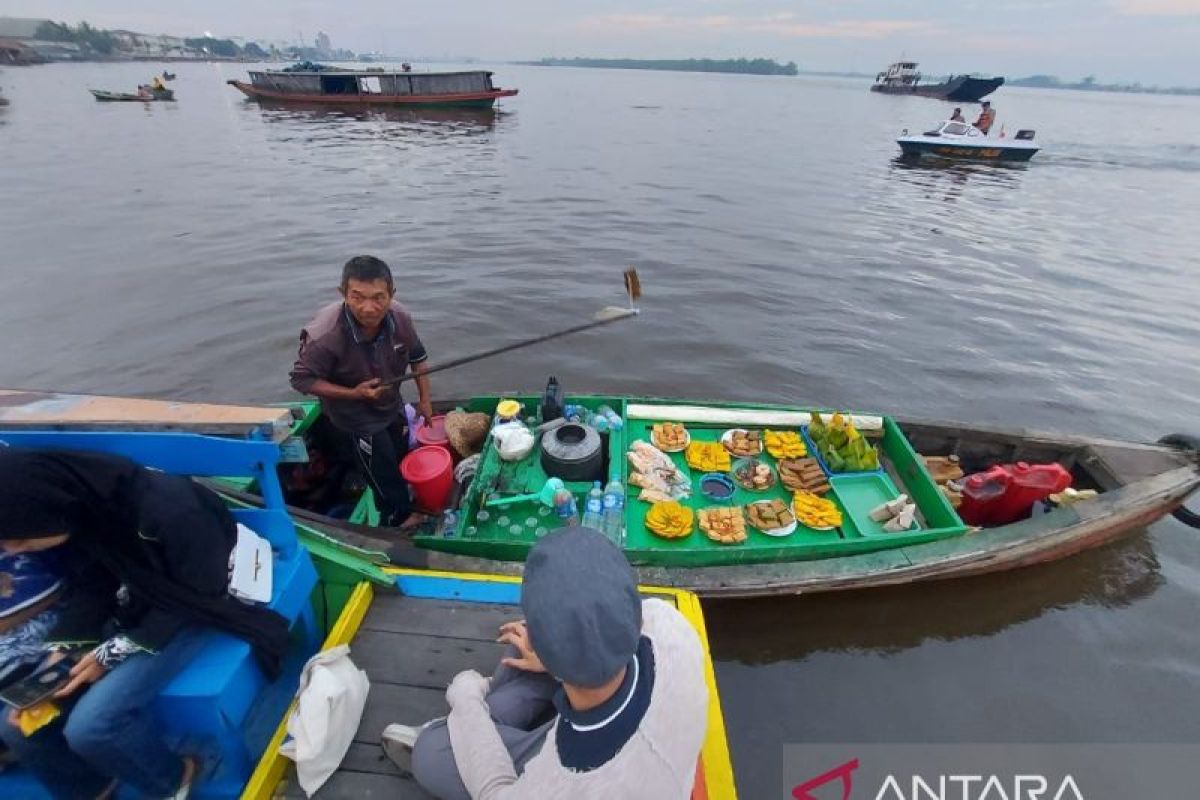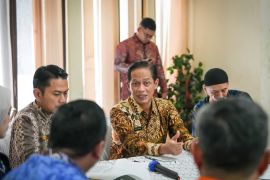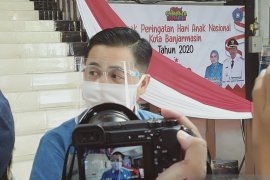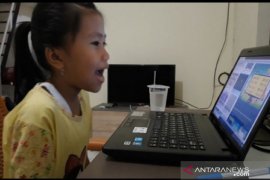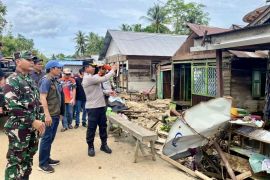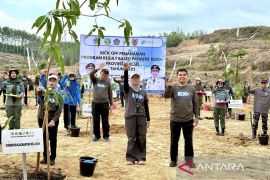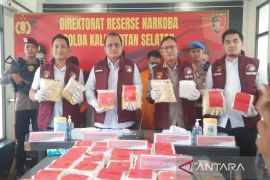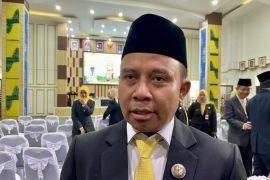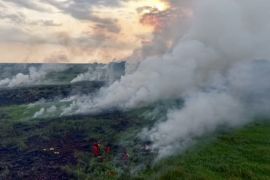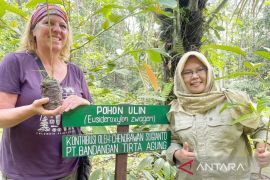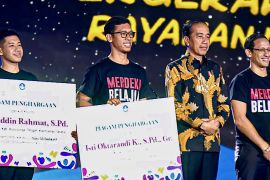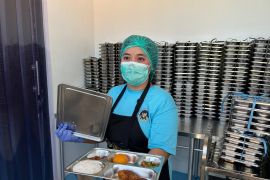She is going there to sell tanggui, a traditional hat typical to South Kalimantan, which is primarily made from Nipah (mangrove palm ) leaves.
"The number of sellers at the Kuin floating market has decreased because they are choosing to sell on land instead," she told ANTARA on the boat headed to the floating market.
Tinah, who goes by one name, used to row her boat to the market to sell tanggui, but she stopped ten years ago after there were no more buyers in the river. The other traders have moved to land-based businesses.
Despite the decline of the floating market, Tinah still visits it regularly every weekend to sell her tanggui .
Tinah's husband died two years ago of COVID-19, and since then, she has been unable to craft as many hats as she used to. On the day we met her, she had only 10 tanggui to sell, which were priced between Rp10 thousand and Rp20 thousand
One of the traders holds tanggui, a traditional hat typical to South Kalimantan, which she plans to sell at the Muara Kuin floating market in Banjarmasin city, South Kalimantan, on September 9, 2023. (ANTARA/Andi Firdaus)
Once our boat arrives at the Kuin floating market, we hear the call of a trader hawking a breakfast menu.
The market, which has been around for 400 years, is the pioneer as well as the oldest floating market in Indonesia. It is located above the Barito river at the mouth of the Kuin River, North Banjarmasin district, South Kalimantan.
The market offers a variety of local necessities ranging from vegetables and fruits, basic foods, and side dishes, to household items. Before money became a method of payment, the Banjar people bartered goods here to meet their daily requirements.
The market is quite famous because it was once used as a filming location for a private television commercial, which is well-known even now.
Banjarmasin is known for its wide canals and vast rivers, which give it its nickname as the city of a thousand rivers.
This has played a significant role in the lives of the Banjar people (the indigenous ethnic group of Banjarmasin) along with the historic floating market, where farmers and traders traditionally supplied goods by boat to the local population.
However, with rapid urban development, including the construction of infrastructure on land, the Kuin floating market in the city center has seen a decline. The atmosphere at the market today is very different from the hubbub seen on television in the 1990s.
Trading at Kuin floating market is now only conducted from dawn to 7 a.m. local time, with just a few traders on boats.
Moving to land
The Muara Kuin floating market once bustled with activity, with the canals bursting with traders until the 1990s.
After the Barito Bridge was built in 1998, the number of sellers at the market started to fall because of fewer buyers frequenting the area.
The construction of kiosks and mini markets offering online services led to further a decline in the Kuin floating market in the city center, with fewer and fewer transactions taking place.
Ardi, 40, a fifth-generation trader from the Muara Kuin floating market, now sells groceries from a stall that he rents for Rp500 thousand per month.
Even though renting a kiosk is more expensive than running a boat stall on the river, Ardi finds that he makes more money from the kiosk on land.
"There aren't many buyers on the river today, but I can earn Rp250 thousand a day on land,” he said while serving a stream of customers.
Best practices
The Muara Kuin floating market is the most prominent relic of the Banjar Kingdom, which was founded in the mid-16th century. Sultan Suriansyah founded the kingdom, which became the forerunner of the city of Banjarmasin, on the banks of the Kuin and Barito Rivers.
Trading activities on the banks of those rivers grew rapidly in the era given its strategic position at the confluence of several tributaries and as a meeting point of the Kuin people with traders from Tamban, Anjir, Alalak, and Berangas.
Madihin artist Ahmad Sya'rani is one of the Banjar people who witnessed the change; and how the identity of "river persons" has now shifted to "land persons."
Madihin is a typical art of the Banjar people from South Kalimantan. Madihin comes from the word madah in Arabic, which means advice. Madihin means the art of conveying advice, information, preaching, and gathering people with poetry or rhymes accompanied to traditional Banjar music.
Madihin artist Ahmad Sya'rani tells a story at the Muara Kuin floating market in Banjarmasin city, South Kalimantan, on September 9, 2023. (ANTARA/Andi Firdaus)
Growing up among Madihin artists, Sya'rani developed an artistic sense. He excels in narrating the story of Banjar's glory through poetry.
In his travels around the world, Sya'rani often misses the atmosphere of the Kuin floating market, which was once filled with good practices, such as no coercion in transactions and traders using rhymes with each other while bargaining.
One of the most special features of the floating market was that money had no use since the trade was done using barter.
"What we are looking for is a clean transaction using sharia (Islamic law) through akad (contract). Exchange what you can and ask for the halal and blessed ones," he said.
The estuary of Barito River was like a barn of life for Sya'rani and his family when they were young. In fact, one could fully pay their education costs just by conducting simple transactions such as bartering coconuts at the Kuin floating market.
Giving up is not an option. Despite the market's decline, we must not give up on preserving the good practices that it represents and make the market an example of ancient practices surviving in modern times.
Related news: PKN highlights fading Muara Kuin Floating Market culture
Related news: Lok Baintan Floating Market listed in 2022 Kharisma Event Nusantara
Related news: Banjarmasin building seven river piers to support tourism
Editor: Sri Haryati
Copyright © ANTARA 2023
